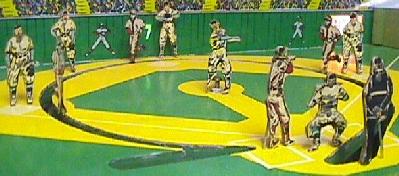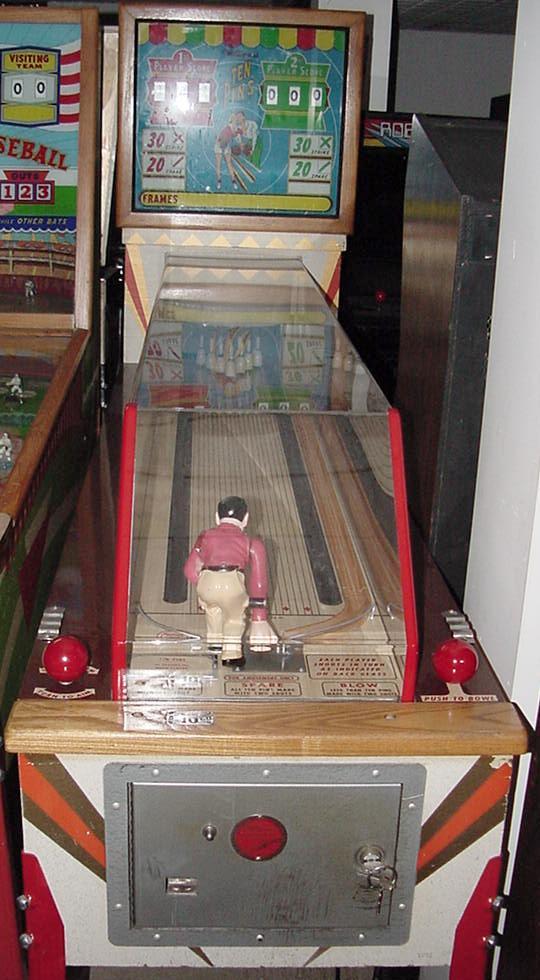Pitch and Bat (Baseball),
Manikin Sport Games &
Mechanical Animation Games.
by cfh@provide.net, 01/02/26.
Copyright 1999-2026, all rights reserved.
I Collect, Buy Pitch & Bat, Manikin, and Mechanical Animation Games!
If you have a sport coin operated such as a "pitch and bat" baseball,
basketball, bowling, boxing, horse race, golf, or any
"manikin" sport game or other coin operated game with mechanical animation
for sale, please contact me! I am looking for many of the games
listed in this document. I buy these games in any condition.
Just email me at
cfh@provide.net
as I'm especially looking for:
- Evans 1948 Bat-A-Score
- Keeney 1940 Texas Leaguer
- Chicago Coin 1958 Batter Up
- Evans 1941 Play Ball
- Rockola 1937 World Series
- Genco 1957 Quarterback
- Chicago Coin 1949 Midget Skee Alley
- Mutoscope 1955 K.O. Champ
- Gottlieb 1940 Skee-Ball-Ette
- Evans 1940 Ski-Ball
- Evans 1940 In the Barrel
How to find a game easily in this document: To easily find a particular game, use the CTRL-F function of your browser, and type in part or all of the game's name to search this document.
Also check out my Bowling & Shuffle Alley web page and EM Arcade, Fortune Teller, Gun Game and Driving game web page for more information on those games.
Scope of this Document.
This document describes coin operated sports games,
manikin, and mechanical animation pinball games made
(mostly) from World War 2 to present. "Pitch and bat" games
are baseball themed (but there are some other non-baseball theme
pitch and bat games too). These games
are similar to (and often classified as) pinball games. The difference is
a small ball is "pitched" to a single large "bat" (flipper), like a pitcher
throws a baseball to a batter. The player(s) control the pitch and the flipper
bat. Points are scored for target hits (single, double, triple, homerun).
Other sports games like coin operated bowling, basketball, boxing and golf games are
also covered here.
Mechanical animation games in this document include horse racing games with
mechanical horses that race, and manikin games (where a small "mini man"
mannequin does some mechanical animation).
The horizontal "running man" unit used in many post-WW2 pitch and bat
baseball games. Small mechanical men run the bases as balls are hit
on the playfield. The horizontal running man unit was first introduced
on in 1950 by Williams on Double Header and 1951 Super World Series
(though the 1950 game had the running men appeared from ABOVE the
baseball field, instead of below it). Williams continued using a horizontal
mechanical running man unit as used on the 1951 Super World Series
until 1973. Here the bases are loaded.

A variation on the baseball running man unit. This Williams
pitch and bat (Touchdown, 1965) has a football themed running
man unit (why are the football players running in circles?!).

-
Running Man Units.
The running man unit, most often used in coin operated baseball games, is a mechanical animation device which moves small two dimensional running base men from base to base. For every hit, a small metal or cardboard player appears in the baseball diamond, and circles the bases. The running man's movement corresponds to the playfield scoring. Most baseball pitch and bat games without a running man animation unit really aren't collectible. The running man animation is what helped make these games popular.
The first baseball running man units were used by Williams from 1947 to 1950. These were VERTICAL running man units, as used on Williams 1947 Box Score and All Stars, 1948 Yanks, 1949 Star Series, and 1950 Lucky Inning. The vertical running man unit was part of the actual backglass score glass. Starting in the fall of 1950, Williams changed to a HORIZONTAL style running man unit. When the horizontal unit was first introduced, the base runners appeared from the TOP of the running man unit, above the baseball field. This was done in 1950 only with the game Double Header (a shuffle alley, and the first game with a horizontal running man unit). Starting in 1951 with Super World Series (a pitch and bat), Williams changed their horizontal running man unit so the running men appeared from underneath the BOTTOM of the baseball field. This made the running man unit much more reliable and less likely to jam (a problem with the 1950 Double Header). Williams used this horizontal running man unit design from 1951 to 1973.
Novelty versus Replay Games.
A replay, or getting a free game,
was considered illegal in some states (New York and Wisconsin for example).
The reason was a replay was seen as gambling.
Many games gave replays for a high score, or a "match". A match was a random
award; if the last digit of your
score matched the number drawn by the game, you got a free
game. Most post-WW2 pinball games gave some kind of replay, but
there were also "novelty" versions of many games that
didn't give replays. Until 1960, novelty games only gave
additional score points for achieving a game goal. But the additional
points didn't net you anything (other than a higher score!).
You couldn't win a free game, or extend your current game
on early novelty games.
Starting in 1960, Gottlieb came up with the idea that giving the player more TIME to play their existing game, instead of a free game, would keep all sides happy. The conservative anti-gambling side could no long complain, as the player wasn't winning a free game. The player was also happy as their game time was extended. The first pinball game that tried this was Gottlieb's 1960 Flipper. This was called an "add a ball" (or AAB) game, because when you achieved a score, you got a free ball. These games were sold mostly in New York and Wisconsin (where replay games were illegal), and some other areas.
The idea of extending game time was also applied to Baseball Pitch and Bat games in 1962. Williams introduced Extra Inning, which didn't give replays. Instead, if a player achieved a game goal, they were awarded an extra inning of play. These games are still known as novelty games (opposed to a replay game). Novelty games existed prior to 1962 too; these games didn't give a replay or extra time, but just higher scores! From about 1953 to 1967, Williams usually produced at least two baseball games per year, but with different titles. They were often the same game, but one was a replay and one was a novelty model. By 1968 Williams stayed with one baseball game title per year, and just made it available as replay or novelty.
Late 1930s and 1940's: Console Games.
The style of the cabinet used on many games during the late 1930s
and 1940s was a woodgrain "console" cabinet. These looked largely
like jukeboxes, with veneer maple or oak encompassing the cabinet.
A very classy style with a very dated antique look. The 1940 Gottlieb
Skee-ball-ette (Skeeballette) and
1940 Evans Ski-Ball and Evan's 1939
Ten Strike are
classic examples of this console style cabinet.
1950's: Woodrail Games.
With the 1950s, game cabinets changed largely from a veneered wood
cabinet to a painted cabinet. This was less expensive than
the hardwood veneer, as stencil patterns were used to paint directly
over the non-veneered plywood sides. Natual solid oak wood was still used though
for the trim around the edges of the cabinet's scoreglass, lockdown
glass molding, and generally anywhere there was glass enclosures.
This 1950s "woodrail" era ended in late 1960/1961 when most games
changed to stainless steel metal side rails and no oak trim
around the scoreglass.
Late 1950's: Multiple Pitch Baseball Games.
Starting in the late 1950's, many pitch and bat games started to have multiple pitches.
This allowed the ball to be pitched fast or slow. A curve or knuckle
ball was used on some games too (a magnet under the playfield achieved the curve). This
worked really well for two player games where one player pitched and the
other batted. Also multiple player sports games became more prevelant.
1960's: Replays versus Extra Innings Baseball Games.
In 1962 Williams
introduced the pitch and bat game Extra Inning.
This game awarded extra innings
(extra play time) for high scores (a "novelty" game),
instead of winning a game (a "replay" game). From about 1953 to 1967
Williams usually produced two baseballs each year; a replay version and a
novelty version with different titles. By 1968, Williams produced just
one baseball title per year that was switchable from replay to novelty
(early on, may state laws perhibited games to be sold that had any
sort of "replay" to them, and companies had to make games that could
not be easily converted to replay).
Late 1960's: Less Popular Pitch and Bat Games.
There were some other ideas tried in the 1960's that weren't
very popular. This included the 1965 Midway Play Ball.
This gave the player a predetermined number of pitches between
25 and 50 (depending on how the game was set up). Targets
on the playfield could give as many as 10 runs.
Another unpopular idea tried was Williams 1969 Fast Ball, which has
an exceptionally wide playfield. Also Williams 1970 Hit and Run,
was another wide body baseball, but had no targets or scoring holes.
Instead there were several horseshoe shaped target areas that the ball could roll around.
There was also a baseball diamond of lights on the playfield. As a
ball rolled around the horseshoe, the lights progressed (like
a runner) on the diamond. When the ball finished its horseshoe,
the playfield light runner stopped. This game was not popular either.
Early 1970's: The Last of the EM Baseball Pitch and Bat Games.
Williams started to get their stride back with 1971's Action Baseball
(a more conventional pitch and bat, but no running man unit). This game
still used the less popular, previous year's "Hit and Run" playfield running man light animation.
But then in 1972 and 1973 Williams released Line Drive and
Upper Deck. These last two games used electronic sounds for crowd noise
and hit sirens, and the conventional mechanical running man unit
in the backbox. Unfortunately 1973's Upper Deck
was the last electro-mechanical (EM) baseball game offered by Williams.
Not until their 1984 electronic Pennant Fever and 1991
Slug Fest
would Williams introduce another pitch and bat game.
Restoring Willams Pitch and Bat "Men" for the Running Man Unit.
The "men" used on the Williams pitch and bat running man unit games from 1951 to 1973
were cardboard. When restoring these games, often the cardboard men in the
infield are damaged. I have scans of some of the players. These can be printed
with a color printer, and then glued onto the face of the damaged players.
These "men"
should be printed as all are 2 5/16" tall or 2 3/8" tall, and the catcher
is 1 3/4" tall. Also the
background can be printed too.
Thanks to M.Gibson for these files.
Right: The mechanical animation in Williams 1951 Sea Jockeys. Each pop bumper on the playfield advances it's respective boat. The first boat to the finish line wins.


Non-Baseball Pitch & Bats, Manikin, and Mechanical Animation Games.
-
There are plenty of other non-baseball pitch and bat and pinball games
that are great. Games like Midway's 1965 Mystery Score, which is a pitch
and bat monster themed game. Also games like Midway's 1963 Race Way,
Flying Turns, which are race car themed games.
These car games have a running
man unit too! But instead of baseball men, race cars go around
a race track.
-
the 1950s brought with it a slew of "horsey" games by Williams.
These games had mechanical animated horses racing through the
backglass (or playfield).
The first game that had this was
Hayburners in 1951. This game had six
horses racing through the backglass. The player was assigned one
of the horses, and his job was to score on bumpers just for his
horse, to advance it first to the finish line. The game ended
when any horse got to the finish line, or when all five pinballs drained.
In addition, between 1951 and 1952 Williams produced some games using the
same mechanism but with other racing themes such as
Jalopy (old cars that race),
Spark Plugs (horse racing),
Sea Jockeys (motor boat racing), and
Handicap (horse racing), all using
the Hayburners mechanism to move little cardboard figures.
Williams took a break until
Daffy Derby in 1954, which was a one flipper
pinball game with the familar mechanical horse running unit.
A different approach to the horse race theme was taken with
Turf Champ in 1958. This pinball
had the horse running unit in playfield instead of the backbox, and was the
only horse race pinball that allowed the player to pick their horse
(instead of the game doing it for them). This game had a very large playfield
width to accomodate the playfield mounted mechanical horses. it also
played badly, because there isn't much playfield area for the ball, and the ball
drains very fast (short game time).
Again there were no horse race games until
Nags in 1960, which was Williams last single player
woodrail pinball game, and used the better backbox mechanical horse
running unit. This was probably the best of the horse race pinball games, as it
used score reel scoring, and had a pop bumper playfield turntable
that rotated during game play!
Williams last use of the horse running unit
was in 1972's Winner,
which again used a playfield mounted horse race unit. But instead
the horses were *under* the playfield, and the player viewed them through
a clear plexiglass window. This saved the playfield for the ball,
but unfortunately Winner just didn't play well and hence is not
very desirable.
Manikin (Mannequin) Games.
(Please email me if you have any of these for sale!)
-
There are other cool mechanical animation
games that use "manikins" (or "mannequin" if you prefer).
There are some baseball manikin games, such as the
Rockola 1937 World Series and
Evans 1948 Bat-A-Score (with the
World Series being the most famous, and the Evan Bat-a-Score
being much more unknown, and not nearly as elaborate as
the 1937 World Series).
But there are plenty of non-baseball manikin games too.
Some very unusual examples includes
H.C. Evans' Ski-Ball (3/40) and
In the Barrel (6/40),
Gottlieb's Skee-Ball-ette (1940),
Chicago Coin's Midget Skee Alley (1949) and
Satomi's Pitch Ball (1972).
I was always a fan of skee bowling, but the size of a skee bowler
makes owning one impossible. Because of this, the manikin versions
are very cool. I would love to find one of these, especially
the Gottlieb Skeeballette.
There are also several basketball manikin games, including Genco's Two Player Basketball (1954), which is probably the most famous. They also make a "jungle" version of this games, called Monkey Jungle. Chicago Coin had the original version (which Genco copied and updated) called Basketball Champ (1947) and the later Pro Basketball (1961), both single player. Another very unusual manikin game is Mutoscope's Silver Gloves (1948). Two manikins actually box each over for the knock out! (I'de love to find one of these too.)
One of the coolest manikin games are the Evans' 1939-1953 Ten Strike, Rockalo's 1940-1942 Ten Pins (a licensed clone of Evans' Ten Strike), and Williams 1957 Ten Strike (or Ten Pins, the novelty version). These games are actually bowling games, but are the size of a pinball game. There is a manikin bowler that the player controls. The "little man" actually bowls a steel 1 1/4" pinball down a lane, which hits small bowling pins. This game was reissued by Williams in 1970 as Mini-Bowl. Sega even copied Williams and came out with their own manikin bowler in the 1972 called Pro-Bowler.
Another manikin game is Williams' 1964 Mini Golf. This game had a manikin golfer, and a nine hole playfield. The object is to putt the ball into the correct golf holes one to nine (a very linear game, since you always started with hole number one!) There were several other manikin golf games related to Mini Golf. The first was Southland Engineering's Little Pro (1964), which was actually the first manikin golf game (Williams bought the rights from Southland to produce the nearly identical, but more well-known, Mini Golf). There is also the 1965 Williams Hollywood Driving Range. The game play is more like a pitch and bat (less linear) Golf game. Hollywood Driving Range also has traditional score reel scoring (instead of just strokes and holes), and backglass animation. Interestingly, in 1991 Bromley released an updated version of the 1964 Mini Golf called Bromley Little Pro, which was a ticket-spitting redemption game. Bromley added some features to the game like electronic scoring and sound, and also hazzards like ramps and a spinning wind mill. The good thing about the Bromley version is you can continue your game. If you could never get past hole three on Mini Golf, at least with Bromley's Little Pro you could continue your current game (for 25 cents!) until finishing all the holes.